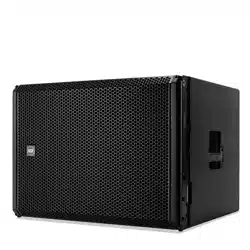Loading ...
Loading ...
Loading ...

LOW FREQUENCY PRESET USING REAR PANEL ROTARY KNOB
The available presets in the rear panel of the loudspeaker, named as “Local” in the software, are only four of the nine
available in RDNet. The numbers are proportional, in terms of gain, to the reduction applied to the low frequencies of all
the clusters.
HIGH FREQUENCY PRESET
The sound propagation, in particular the high frequencies (1.5 KHz and up), depends essentially on the conditions of the
air in which it travels. We can generally affirm that air absorbs high frequencies and the amount of absorption depends
on temperature, humidity and the distance that the sound should would carry.
The decibel decrease is well modelled by a mathematical formula that combines the three parameters (temperature,
humidity and distance) giving a profile of the absorption in function of the frequency.
In the case of a loudspeaker array the goal is the audience coverage
with the best possible uniformity, obtainable only by compensating
for the absorption introduced by air. It is easy to understand that
every cabinet should be compensated differently from the other array
cabinets because the compensation should consider the distance at
which the cabinet is aiming: the cabinet at the top of the cluster will
have a bigger compensation than the one below, which in turn will
compensate more than the one below that, etc. The compensation
should be translated in terms of decibels that should be progressively
added with the increase of high frequencies.
It is important to note that the formula gives an absorption that
exponentially increases with the increase of the frequency: in
particular conditions the compensation requests a gain too high for
the amplifier.
Consider as example the following conditions: 20°C of
temperature, 30% of relative humidity and 70m of distance to
cover. In these conditions the necessary compensation, from 10
KHz and up, starts from 25 dB up to a maximum of 42 dB at 20
KHz (Figure 5). The headroom of the system cannot permit such
high gains.
Considering everything described, 15 compensation levels were
selected in order to approximate at best the infinite number of
compensation curves derived from the mathematical formula.
A low pass filter is progressively introduced with the increase of the compensation gain: the system does not need to
reproduce frequencies that could hardly reach the desired distance and that could lead to a waste of useful energy.
The picture below (Figure 6) shows the behavior of the 15 filters. These filters are designed as very small FIR (finite
impulse response) filters in order to preserve the phase coherence of the system.
The RCF Easy Shape Designer algorithm calculates the curve that best fits the one that would be seen in the real world.
Considering it is an approximation, the generated filters set should be validated with measurements or listening and
eventually changed in order to reach the desired listening experience.
Loading ...
Loading ...
Loading ...
